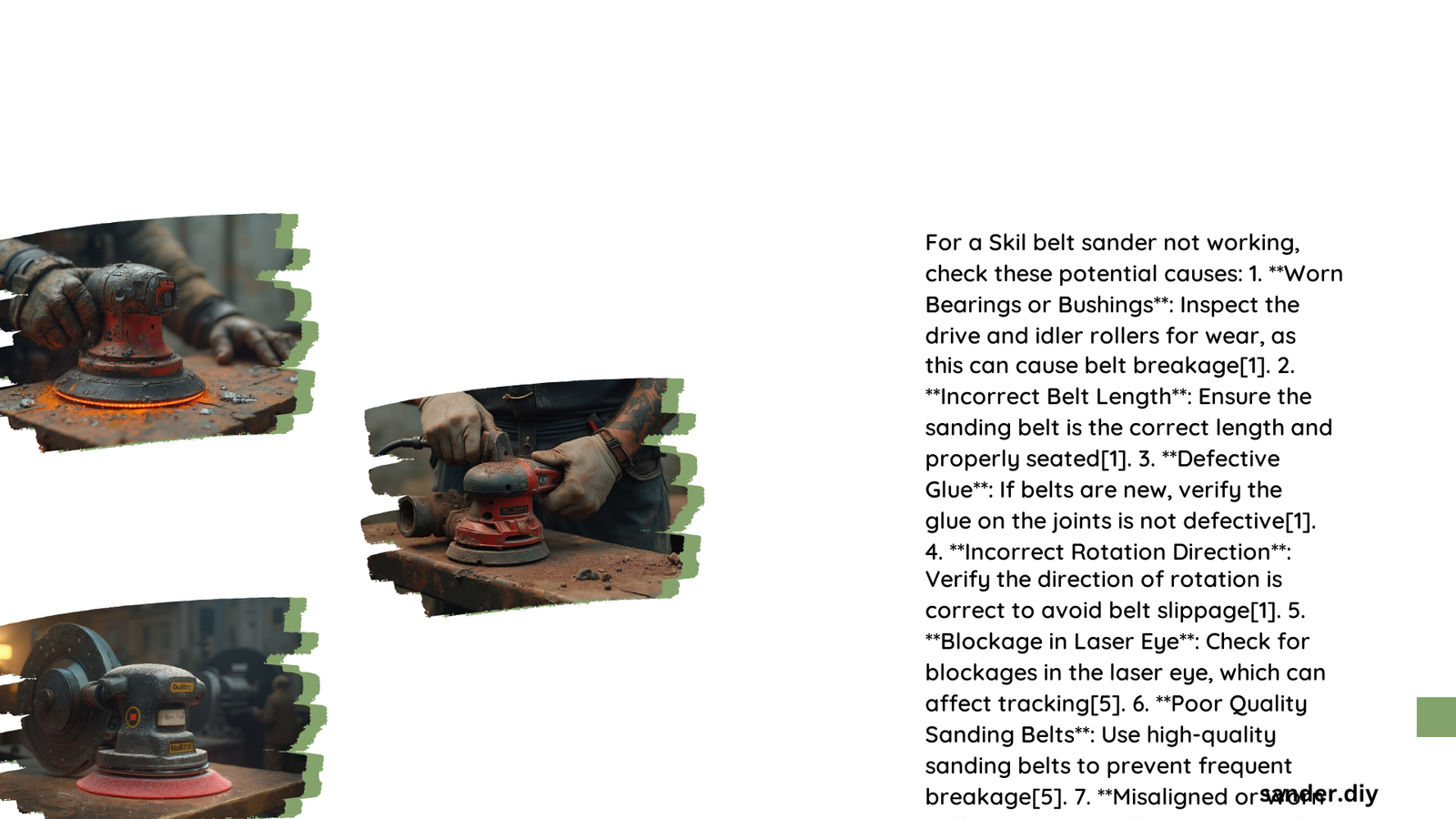A Skil belt sander that’s not working can be frustrating for DIY enthusiasts and professionals alike. Common issues include power supply problems, motor failure, and circuit malfunctions. This comprehensive guide will help you diagnose and troubleshoot your Skil belt sander, covering everything from simple power checks to more complex motor and circuit repairs. By following these steps, you can potentially save time and money on repairs or replacements.
What Are the Most Common Reasons for a Skil Belt Sander to Stop Working?
- Power Supply Issues
- Motor Failure
- Circuit Problems
- Mechanical Obstructions
- Worn-out Components
Let’s dive deeper into each of these potential causes and explore how to address them.
How Can I Diagnose Power Supply Problems in My Skil Belt Sander?

Power supply issues are often the simplest to diagnose and fix. Here’s a step-by-step guide to troubleshooting power-related problems:
-
Check the Power Source: Ensure your Skil belt sander is plugged into a working outlet. The Skil 6 Amp Belt Sander typically operates on 120V AC.
-
Inspect the Power Cord: Look for any visible damage, cuts, or frays in the power cord. If you find any, the cord will need to be replaced.
-
Test the Outlet: Use a voltage tester or plug in another device to confirm the outlet is functioning correctly.
-
Check the Circuit Breaker: Verify that the circuit breaker hasn’t tripped. If it has, reset it and try the sander again.
-
Examine the Fuse: If your home uses fuses, check if the relevant fuse has blown. Replace it if necessary.
| Component | What to Check | How to Fix |
|---|---|---|
| Power Outlet | Voltage output | Use another outlet or repair existing one |
| Power Cord | Visible damage | Replace if damaged |
| Circuit Breaker | Tripped state | Reset if tripped |
| Fuse | Blown state | Replace if blown |
What Are the Signs of Motor Failure in a Skil Belt Sander?
Motor failure can be more serious and may require professional repair or replacement. Here are some symptoms to watch for:
- The sander doesn’t turn on at all
- Unusual noises or excessive vibration during operation
- The motor overheats quickly
- Sudden loss of power or abrupt slowdowns
If you suspect motor failure, here’s how to proceed:
- Safety First: Unplug the sander before any inspection.
- Visual Inspection: Remove the housing and look for signs of burning or damage.
- Smell Test: A burnt odor often indicates motor failure.
- Continuity Test: Use a multimeter to check for continuity between motor terminals.
How Do I Troubleshoot Circuit Problems in My Skil Belt Sander?
Circuit issues can cause intermittent power, complete loss of function, or erratic operation. Follow these steps to diagnose and potentially fix circuit problems:
-
Disconnect Power: Always unplug the sander before any internal inspection.
-
Inspect Wiring: Look for loose connections, damaged wires, or signs of overheating.
-
Check the Switch: Ensure the power switch is functioning correctly. The ‘Lock-ON’ button, if engaged, can prevent the trigger from releasing.
-
Test Components: Use a multimeter to test continuity and voltage across various circuit components.
-
Clean Connections: Use electrical contact cleaner to remove any dust or debris from connections.
What Tools Do I Need to Repair My Skil Belt Sander?
To effectively troubleshoot and repair your Skil belt sander, you’ll need the following tools:
- Multimeter
- Screwdrivers (flathead and Phillips)
- Pliers
- Wire strippers
- Electrical tape
- Soldering iron (for advanced repairs)
How Can I Prevent Future Issues with My Skil Belt Sander?
Prevention is always better than cure. Here are some tips to keep your Skil belt sander in top condition:
- Regular Cleaning: Remove dust and debris after each use.
- Proper Storage: Store in a dry, clean place to prevent moisture damage.
- Inspect Before Use: Check for visible damage or wear before each use.
- Avoid Overloading: Don’t force the sander or use it beyond its capacity.
- Maintain Proper Belt Tension: Ensure the sanding belt is correctly tensioned.
When Should I Consider Replacing My Skil Belt Sander?
Sometimes, replacement is more cost-effective than repair. Consider replacing your Skil belt sander if:
- The cost of repairs exceeds 50% of a new sander’s price
- The sander is more than 10 years old and has frequent issues
- You need features or power that your current model doesn’t offer
Remember, proper maintenance and timely repairs can significantly extend the life of your Skil belt sander. However, if you’re unsure about performing repairs yourself, it’s always best to consult a professional to avoid potential injury or further damage to the tool.
By following this guide, you should be able to diagnose and potentially fix many common issues with your Skil belt sander. Always prioritize safety and don’t hesitate to seek professional help for complex repairs.
References:
1. SKIL Power Tools Operating Instructions – CARiD.com
2. SKIL Belt Sander Manual
3. Skil 6 Amp Belt Sander Review – Serious Flaw and Easy Fix – YouTube
